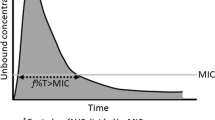Abstract
A variety of pharmacodynamic, pharmacokinetic and drug stability factors can influence the choice of drug, the dosing regimen and the method of drug administration for outpatient parenteral antibiotic therapy (OPAT). Beta-lactam antibiotics exhibit little if any concentration-dependent killing and produce short-term or no persistent effects with most bacterial pathogens. Optimal dosing regimens for these agents should provide serum levels that continually exceed the minimal inhibitory concentration (MIC) of the pathogen. Beta-lactam agents with long half-lives (greater than 2 hours) can provide these levels with intermittent dosing once or twice daily. Beta-lactam agents with shorter half-lives can be administered by programmable pumps or by continuous infusion providing the drug is sufficiently stable to degradation in solution. Imipenem and ampicillin are examples of drugs with short half-lives that are unstable in solution and must be dosed intermittently. Intramuscular administration slows absorption and can also prolong the length of time during which serum levels exceed the MIC of infecting bacteria. Aminoglycosides and fluoroquinolones, on the other hand, exhibit concentration-dependent killing and produce prolonged persistent effects. Optimal dosage regimens of these drugs should maximize serum levels. Once-daily dosing regimens for the aminoglycosides meet this goal and also appear to reduce drug-induced nephrotoxicity. Application of these principles to drug selection and administration in a hospital-based OPAT program has provided efficacious therapy and a low incidence of adverse reactions in an elderly population distributed over a wide geographic area.
Similar content being viewed by others
References
Craig WA, Ebert S: Killing and regrowth of bacteria in vitro: a review. Scandinavian Journal of Infectious Diseases 1991, Supplement 74: 63–70.
Vogelman B, Craig WA: Postantibiotic effects. Journal of Antimicrobial Chemotherapy 1985, 15, Supplement A: 37–46.
Odenhold-Tornqvist I, Holm SE, Cars O: Pharmacodynamic effects of subinhibitory antibiotic concentrations. Scandinavian Journal of Infectious Diseases 1991, Supplement 74: 94–101.
McDonald PJ, Wetherall BL, Pruul H: Postantibiotic leukocyte enhancement: increased susceptibility of bacteria pretreated with antibiotics to activity of leukocytes. Reviews of Infectious Diseases 1981, 3: 38–44.
Craig WA: Selecting the antibiotic. Hospital Practice 1993, 28, Supplement 1: 16–20.
Craig WA: Postantibiotic effects in experimental infection models: relationship to in vitro phenomena and to treatment of infection in man. Journal of Antimicrobial Chemotherapy 1993, 31, Supplement D: 149–158.
Craig WA, Redington J, Ebert SC: Pharmacodynamics of amikacin in vitro and in mouse thigh and lung infections. Journal of Antimicrobial Chemotherapy 1991, 27, Supplement C: 29–40.
Leggett JE, Fantin B, Ebert S, Totsuka K, Vogelman B, Calme W, Mattie H, Craig WA: Comparative antibiotic dose-effect relations at several dosing intervals in murine pneumonitis and thigh-infection models. Journal of Infectious Diseases 1989, 159: 281–292.
Vogelman B, Gudmundsson S, Leggett J, Tumidge J, Ebert S, Craig WA: Correlation of antimicrobial pharmacokinetic parameters with therapeutic efficacy in an animal model. Journal of Infectious Diseases 1988, 158: 831–847.
Moore RD, Lietman PS, Smith CR: Clinical response to aminoglycoside therapy: importance of peak concentration to minimal inhibitory concentration. Journal of Infectious Diseases 1987, 155: 93–99.
Forrest A, Nix DE, Ballow CH, Goss TF, Birmingham MC, Schentag JJ: Pharmacodynamics of intravenous ciprofloxacin in seriously ill patients. Antimicrobial Agents and Chemotherapy 1993, 37: 1073–1081.
Schentag JJ, Smith IL, Swanson DJ, DeAngelis C, Fracasso JE, Vari A, Vance JW: Role for dual individualization with cefmenoxime. American Journal of Medicine 1984, 77, Supplement 6A: 43–50.
Syndman DR, Cuchural GJ, McDermott L, Gill M: Correlation of various in vitro testing methods with clinical outcomes in patients withBacteroides fragilis group infections treated wit cefoxitin: a retrospective analysis. Antimicrobial Agents and Chemotherapy 1992, 36: 540–544.
Weinstein MP, Stratton CW, Hawley HB, Ackley A, Relier LB: Multicenter collaborative evaluation of a standardized serum bactericidal test as a predictor of therapeutic efficacy in acute and chronic osteomyelitis. American Journal of Medicine 1987, 83: 218–226.
Williams DN, Gibson JA, Bosch D: Home intravenous antibiotic therapy using a programmable infusion pump. Archives of Internal Medicine 1989, 149: 1157–1160.
Craig WA, Ebert SC: Continuous infusion of beta-lactam antibiotics. Antimicrobial Agents and Chemotherapy 1992, 36: 2577–2583.
Hodges TL, Zighelboim-Daum S, Eliopoulos GM, Wennersten C, Moellering JRC: Antimicrobial susceptibility changes inEnterococcus faecalis following various penicillin exposure regimens. Antimicrobial Agents and Chemotherapy 1992, 36: 121–125.
Moreillon P, Tomasz A: Penicillin resistance and defective lysis in clinical isolates of pneumococci: evidence for two kinds of antibiotic pressure operating in the clinical environment. Journal of Infectious Diseases 1988, 157: 1150–1157.
Visser LG, Arnouts P, van Furth R, Mattie H, van der Broek PJ: Clinical pharmacokinetics of continuous intravenous administration of penicillins. Clinical Infectious Diseases 1993, 17: 491–495.
Russo TA, Cook S, Gorbach SL: Intramuscular ceftriaxone in home parenteral therapy. Antimicrobial Agents and Chemotherapy 1988, 32: 1439–1440.
Blaser J, Stone BB, Groner MC, Zinner SH: Comparative study with enoxacin and netilmicin in a pharmacodynamic model to determine importance of ratio of antibiotic peak concentration to MIC for bacterial activity and emergence of resistance. Antimicrobial Agents and Chemotherapy 1987, 31: 1054–1060.
Mattie H, Craig WA, Pechere JC: Determinants of efficacy and toxicity of aminoglycosides. Journal of Antimicrobial Chemotherapy 1989, 24: 281–293.
De Broe MA, Verbist L, Verpooten GA: Influence of dosage schedule on renal cortical accumulation of amikacin and tobramycin in man. Journal of Antimicrobial Chemotherapy 1991, 27, Supplement C: 41–47.
Verpootten GA, Guiliano RA, Verbist L, Eestermans G, De Broe ME: Once-daily dosing decreases renal accumulation of gentamicin and netilmicin. Clinical Pharmacology and Therapeutics 1989, 45: 22–27.
Craig WA: Once-daily dosing of aminoglycosides. Canadian Journal of Infectious Diseases 1994, Supplement C: 28–33.
Neftel KA: Effect of storage of penicillin-G solutions on sensitization to penicillin-G after intravenous administration. Lancet 1982, i: 986–988.
Neftel KA, Walti M, Schulthess HK, Gubler J: Adverse reactions following intravenous penicillin-G relate to degradation of the drugs in vitro. Klinische Wochenschrift 1984, 62: 25–29.
Author information
Authors and Affiliations
Rights and permissions
About this article
Cite this article
Craig, W.A. Antibiotic selection factors and description of a hospital-based outpatient antibiotic therapy program in the USA. Eur. J. Clin. Microbiol. Infect. Dis. 14, 636–642 (1995). https://doi.org/10.1007/BF01690745
Issue Date:
DOI: https://doi.org/10.1007/BF01690745




